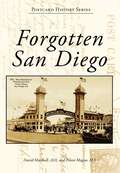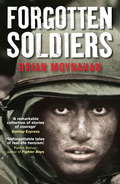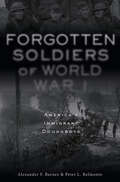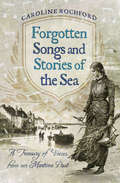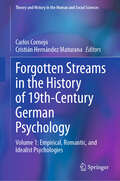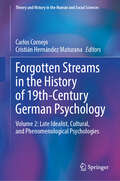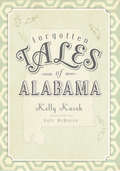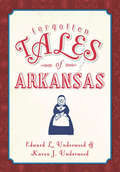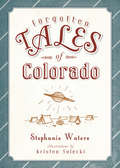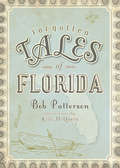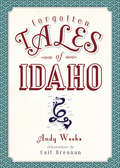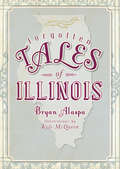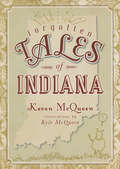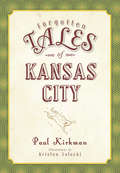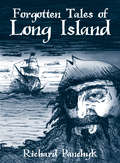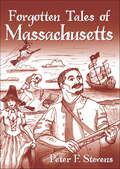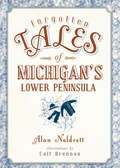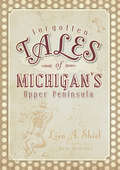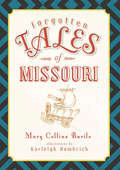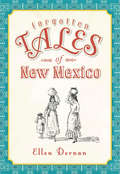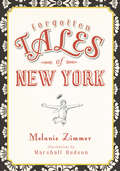- Table View
- List View
Forgotten San Diego (Postcard History Series)
by David Marshall Eileen MagnoMemories are fleeting, and a region's history can easily be forgotten. This book features over 200 unique and interesting historical postcards that vividly capture San Diego County's forgotten past from 1890 to 1990. From bowling alleys to military bases, from giant dirigibles to sleek airplanes, from billionaires to bulldogs--San Diego has changed so fundamentally that much of its charming history has faded from our memories. Forgotten San Diego showcases the unique evolution of San Diego and its neighboring cities, making sure that the triumphs, tragedies, and oddities of this region live on.
Forgotten Schools: Right to Basic Education for Children on Farms in South Africa
by Human Rights WatchThe South African government is failing to protect the right to a primary education for children living on commercial farms by neither ensuring their access to farm schools nor maintaining the adequacy of learning conditions at these schools. This violates South Africa's 1996 South African Schools Act (Schools Act), the National Education Policy Act, and its obligations under the Convention on the Rights of the Child. Receiving an education is compulsory for all children up to grade nine or age fifteen, depending on whichever comes first. The historical, social and economic conditions on commercial farms, inherited from years of an undemocratic minority government, mean that farm schools public schools on private commercial farms, which constitute 13 percent of all state-funded schools and provide education to about 3 percent of learners in the public school system are among the poorest in financial resources, physical structure and quality in South Africa. Farm children may attend schools without electricity, drinking water, sanitation, suitable buildings or adequate learning materials. Also, children may face harassment from farm owners.
Forgotten Skills of Cooking: 700 Recipes Showing You Why the Time-honoured Ways Are the Best
by Darina AllenWinner of the Andre Simon Food Book Award 2009.Darina Allen has won many awards such as the World Gourmand Cookbook Award 2018, the Award for Outstanding Contribution to the Irish Culinary Sector by Euro-Toques, the UK Guild of Food Writers Lifetime Achievement Award and the 2018 Guaranteed Irish Food Hero Award.'There's not much this gourmet grande dame doesn't know.' Observer Food MonthlyIn this sizeable hardback, Darina Allen reconnects you with the cooking skills that missed a generation or two. The book is divided into chapters such as Dairy, Fish, Bread and Preserving, and forgotten processes such as smoking mackerel, curing bacon and making yogurt and butter are explained in the simplest terms. The delicious recipes show you how to use your home-made produce to its best, and include ideas for using forgotten cuts of meat, baking bread and cakes and even eating food from the wild. The Vegetables and Herbs chapter is stuffed with growing tips to satisfy even those with the smallest garden plot or window box, and there are plenty of suggestions for using gluts of vegetables. You'll even discover how to keep a few chickens in the garden. With over 700 recipes, this is the definitive modern guide to traditional cookery skills.
Forgotten Skills of Cooking: 700 Recipes Showing You Why the Time-honoured Ways Are the Best
by Darina AllenBased on the hugely popular courses at Darina Allen's Ballymaloe Cookery School, this book reveals the lost art of making creamy butter and yoghurt, keeping a few hens in the garden, home-curing and smoking bacon, and even foraging for food in the wild.So many of our happiest childhood memories are connected to food. Rediscover the flavours of all-time favourites such as traditional stuffed roast chicken, figgy toffee pudding, and freshly baked scones with strawberry jam. Darina also offers lots of thrifty tips for using up leftovers in delicious ways.Essential reading for urban and rural dwellers alike, this is the definitive modern guide to traditional cookery skills.'There's not much this gourmet grande dame doesn't know.' Nigel Slater, Observer Food Monthly'Our first lady of food.' The Irish Independent'Ireland's answer to Delia and Nigella.' Sunday Telegraph Stella magazine
Forgotten Skills of Cooking: 700 Recipes Showing You Why the Time-honoured Ways Are the Best
by Darina AllenBased on the hugely popular courses at Darina Allen's Ballymaloe Cookery School, this book reveals the lost art of making creamy butter and yoghurt, keeping a few hens in the garden, home-curing and smoking bacon, and even foraging for food in the wild.So many of our happiest childhood memories are connected to food. Rediscover the flavours of all-time favourites such as traditional stuffed roast chicken, figgy toffee pudding, and freshly baked scones with strawberry jam. Darina also offers lots of thrifty tips for using up leftovers in delicious ways.Essential reading for urban and rural dwellers alike, this is the definitive modern guide to traditional cookery skills.'There's not much this gourmet grande dame doesn't know.' Nigel Slater, Observer Food Monthly'Our first lady of food.' The Irish Independent'Ireland's answer to Delia and Nigella.' Sunday Telegraph Stella magazine
Forgotten Soldiers
by Brian MoynahanForgotten Soldiers is an enthralling work of military history that shows how the courage, intelligence or simple good fortune of the individual can exert a decisive influence on the outcome of a battle or campaign. It tells the stories of fifteen unsung heroes, none of a rank higher than major, whose deeds changed the course of important battles and - arguably - the course of history. These vivid and gripping accounts - largely drawn from the Second World War, but with tales too from other conflicts - have each been selected to illustrate one of the dictums of the great Prussian theorist of war, Carl von Clausewitz, about the importance of having the right man in the right place at the right time. From the Roman standard bearer who plunged into the waves off Deal in 55 BC, saving Julius Caesar's military honour and political career, to the young Israeli tank lieutenant who almost single-handedly stalled the advancing Syrian armour in 1973, these are above all tales of courage. But it is not just courage that wins wars, as these stories demonstrate: such elements as surprise, determination, good intelligence, chance, insight, inventiveness and clear thinking all play their parts in eventual victory. And it may only take one man, often of lowly rank, his name largely forgotten, to embody such qualities for the effect to be felt around the world.
Forgotten Soldiers of WWI: America's Immigrant Doughboys
by Alexander F. Barnes Peter L. BelmonteDuring World War I, hundreds of thousands of foreign-born soldiers served in the US military
Forgotten Songs and Stories of the Sea: A Treasury of Voices from our Maritime Past
by Caroline RochfordA collection of fascinating folklore and maritime trivia about pirates, explorers, naval battles, shipwrecks, sea monsters, and more. Stirring tales of heroism at sea have been ingrained in the annals of maritime history from time immemorial. Christopher Columbus&’s discovery of the New World, Queen Elizabeth I&’s defeat of the Spanish Armada, and Horatio Nelson&’s victory at Trafalgar are just some of Britain&’s most memorable naval triumphs. But what about the lesser-known tales from its seafaring past? The Victorian who invented a swimming machine in order to cross the English Channel; the capture of a real-life mermaid; the lost pirate treasure of Alborn; the ghost of a murdered sailor who still haunts the streets of Portsmouth; and the daring explorers who vanished into the blue yonder, leaving behind nothing but a cryptic message in a champagne bottle—these are just some of the quirky naval stories that have been chronicled in verse and archived in newspaper clippings, and forgotten with the passage of time. Historian and genealogist Caroline Rochford has compiled 200 traditional songs and stories into this book, which offers an exciting, entertaining and eye-opening glimpse into a long-lost maritime past.
Forgotten Streams in the History of 19th-Century German Psychology: Volume 1: Empirical, Romantic, and Idealist Psychologies (Theory and History in the Human and Social Sciences)
by Carlos Cornejo Cristián Hernández MaturanaThe 19th century was a defining era for psychology, rich with an intellectual diversity that shaped modern thought but which remains largely overlooked. The roots of 20th century thought can be traced to the 19th century, when a mechanical worldview took hold, society grew increasingly secular, modern urban metropolises emerged, and evolutionist ideas reshaped the understanding of nature’s developmental principles. Throughout this century, the natural sciences extended beyond their traditional limits, influencing and reshaping the human, moral, and social sciences, among which psychology was especially impacted, as this transformation sparked profound debates on the very possibility of a science of the soul. Forgotten Streams in the History of 19th-Century German Psychology recovers the vibrant roots of psychology in empiricism, romanticism, idealism, phenomenology, among other streams of thought that explored consciousness, the soul, and the self before experimental psychology took center stage. Unlike the standard view, this book invites readers to reconsider psychology’s history, revealing a complex landscape that questions the simplistic story of a linear path toward empiricism. Through profiles of significant yet forgotten thinkers, this work uncovers how their ideas contributed to discussions of the unconscious, mind-body duality, and inner experience. Written by leading scholars, each chapter offers a unique window into an intellectual movement that continues to influence debates in psychology, philosophy, and beyond. Essential for historians, psychologists, and anyone curious about psychology’s deeper origins, Forgotten Streams is an indispensable reference that fills an important gap, enriching our understanding of psychology’s complex and multifaceted development.
Forgotten Streams in the History of 19th-Century German Psychology: Volume 2: Late Idealist, Cultural, and Phenomenological Psychologies (Theory and History in the Human and Social Sciences)
by Carlos Cornejo Cristián Hernández MaturanaThe 19th century was a defining era for psychology, rich with an intellectual diversity that shaped modern thought but which remains largely overlooked. The roots of 20th century thought can be traced to the 19th century, when a mechanical worldview took hold, society grew increasingly secular, modern urban metropolises emerged, and evolutionist ideas reshaped the understanding of nature’s developmental principles. Throughout this century, the natural sciences extended beyond their traditional limits, influencing and reshaping the human, moral, and social sciences, among which psychology was especially impacted, as this transformation sparked profound debates on the very possibility of a science of the soul. Forgotten Streams in the History of 19th-Century German Psychology recovers the vibrant roots of psychology in empiricism, romanticism, idealism, phenomenology, among other streams of thought that explored consciousness, the soul, and the self before experimental psychology took center stage. Unlike the standard view, this book invites readers to reconsider psychology’s history, revealing a complex landscape that questions the simplistic story of a linear path toward empiricism. Through profiles of significant yet forgotten thinkers, this work uncovers how their ideas contributed to discussions of the unconscious, mind-body duality, and inner experience. Written by leading scholars, each chapter offers a unique window into an intellectual movement that continues to influence debates in psychology, philosophy, and beyond. Essential for historians, psychologists, and anyone curious about psychology’s deeper origins, Forgotten Streams is an indispensable reference that fills an important gap, enriching our understanding of psychology’s complex and multifaceted development.
Forgotten Tales of Alabama (Forgotten Tales)
by Kelly KazekFrom Muscle Shoals to Montgomery to Mobile, there's just no place quite like Alabama. Take a journey off the beaten path through the Cotton State with author Kelly Kazek as she uncovers the stories that make Alabama one of a kind. Kazek, a longtime Alabama resident, unearths tales that have existed only in rumor, anecdote, legend and lore. This collection is packed with little-known stories of strange sites, like the world's largest Nehi bottle; curious critters, like the first monkey in space; and colorful characters, such as the outlaw Tom Clark. Whether funny, far-fetched, gripping or grisly, Forgotten Tales of Alabama is filled with stories you won't soon forget.
Forgotten Tales of Arkansas (Forgotten Tales)
by Karen J. Underwood Edward L. UnderwoodTake a journey through Arkansas' forgotten past and find the colorful characters, unusual stories and strange occurrences left out of conventional history books. Authors Edward and Karen Underwood weave fact and fun in this offbeat, gripping and little-known history of the Natural State. Discover the Tantrabobus monster rumored to lurk in the hills of the Ozarks, meet the imposters who faked the state's first history museum and learn the story behind Arkansas' lost amusement park, Dogpatch, USA. Truth really is stranger than fiction in Arkansas, and this one-of-a-kind state has the stories to prove it
Forgotten Tales of Colorado (Forgotten Tales)
by Stephanie WatersWild characters, diverse cultures, spooky myths and slippery sales schemes color Colorado's past. In a place where shameless showdowns and dusty shootouts over money, drink and women were once standard procedure, storytelling around campfires became an integral part of a rich heritage. From the jackalope and vampires to Indian curses and snake oil salesmen, the Centennial State has it all. Weirder still are the strange but true stories like that of the first body buried in La Junta's Fairview Cemetery, a man who landed there for refusing alcohol to a kid, and that of the hotel in Telluride that once offered a promotion that included funeral costs with your stay. While history may have neglected these silly, seedy and salacious stories, author Stephanie Waters has rediscovered Colorado's best forgotten tales.
Forgotten Tales of Florida (Forgotten Tales)
by Bob PattersonWith such a rich and significant history, it�s only natural that some of the best stories from the Sunshine State have been forgotten over time. Thankfully, master storyteller and St. Augustine resident Bob Patterson offers this collection of thestrangest, most fascinating stories and legends in Florida�s history from coast to coast, swamp to swamp. Enjoy the saga of William Ellis, a North Florida nature whisperer who escaped from his nursing home with the help of his varmint friends; step into the murk and mystery of the vanishing tribes of the Everglades; and could there really be gator-hungry sharks lurking in the St. John�s River? These stories and so many moreawait when you explore the Forgotten Tales of Florida.
Forgotten Tales of Idaho (Forgotten Tales)
by Andy Weeks Cait BrennanIdaho was the forty-third state admitted to the Union, but it just might lead the nation in strange stories and offbeat legends. Author and Idaho resident Andy Weeks fills this collection of tales with stories ranging from compelling and heartfelt to outlandish and bizarre. Discover the boxcar that carried the alleged body of John Wilkes Booth through Idaho. Uncover the identity of Lady Bluebeard, the unassuming Twin Falls housewife who allegedly murdered four husbands. Find out how cars ended up at the bottom of Lake Coeur d'Alene. Learn the grisly story of Gobo Fango, a black Mormon sheepherder whose late 1800s bloody dispute with a cattleman on the open range proved fatal. These tales and many others bring to light Idaho's unruly past in fascinating detail.
Forgotten Tales of Illinois (Forgotten Tales)
by Bryan AlaspaDig up the men who tried to dig up Lincoln. Mull over the Mad Gasser of Mattoon and the 1977 thunderbird infestation, from a safe distance. Watch in horror as one of the greatest maritime disasters in U.S. history occurs twenty feet from the banks of the Chicago River or follow the course of the blimp crash that convinced a downtown bank employee that it was raining hell. Try not to blink as towns washed away by floods and shrines covered over by condominiums are dragged back from the margins of history into the center of the page, where they belong. After all, reasons author Bryan Alaspa, if the pope was eager to stop by the House of Crosses during his visit to Chicago, surely it is worth a look. Just beware: a quick glance into this book and you might not look up until you've read the whole gripping and grin-inspiring collection.
Forgotten Tales of Indiana (Forgotten Tales)
by Keven Mcqueen Kyle McqueenAuthor Keven McQueen recalls a time when skunk farms, which allegedly produced a cure for rheumatism, were speckled throughout the countryside and a miserable woman tied her husband to a fence post, coated him with salt and intended to let the cows "lick him to death."? Meet the King of the Ghouls, an accomplished grave robber and notorious murderer, and a man so convinced he was an ox that he often joined neighborhood cattle for a bite of grass, and discover ghosts, monsters, giant skeletons and more in this collection of outlandish tales from the Hoosier State.
Forgotten Tales of Kansas City (Forgotten Tales)
by Paul KirkmanMeet the folks who slip out of history books like they're playing the Kansas City shuffle. In this fascinating collection of stories, Paul Kirkman has dug up all sorts of head-scratchers: how did Jesse James rob a bank with John F. Kennedy, and how could a Beatles concert in the 1960s fail to make money? Watch a cow explode in a kitchen, frogs rain down from the sky and dogs pay for a public library system. Learn how Harry Houdini was trapped in a phone booth, why Clark Gable haunted street corners in a clown outfit and what kept Kansas City in Missouri.
Forgotten Tales of Long Island (Forgotten Tales)
by Richard PanchykIn this enthralling new book, Richard Panchyk has compiled a collection of true stories from Long Island�s history sure to befuddle, baffle and bemuse even lifelong residents. Who knew that Plum Island was bought with a barrel of biscuits and a few fishhooks? Or that an Oyster Bay woman accused of being a witch was instead found guilty of being a Quaker? Little-known tales of snake-eyed horses, naked ghosts, swamp serpents and cats riding horses offer a fresh look at Long Island�s past. Culled from numerous period sources, including newspapers, books and historical records, these little stories are notable both as entertaining anecdotes and as forgotten history.
Forgotten Tales of Massachusetts (Forgotten Tales)
by Peter F. StevensW hen the first Pilgrims arrived on the shores of Massachusetts, they set foot in a world full of promise and new beginnings. Colonists witnessed the births of new children, governments and traditions, but even the Puritans could not wholly escape the Old World�s basest human instincts. In Plymouth, John Billington committed the nation�s first murder, and in Boston, the �Mass Bay Madam� Alice Thomas opened the first brothel. A Charlestown midwife and healer was hanged for witchcraft. Yet Massachusetts also produced William Phips, America�s first undersea treasure hunter; Peter Salem, the first black war hero; Ann Bradstreet, pioneer poetess; and William Ives, printer of the first board game. In these dramatic and vividly imaginative tales, Peter Stevens narrates fascinating episodes from Massachusetts history, piecing together forgotten yet essential aspects of American identity.
Forgotten Tales of Michigan's Lower Peninsula (Forgotten Tales)
by Alan NaldrettSome of Michigan's most noteworthy yarns and compelling characters were lost down the corridors of history--until now. Discover the Nain Rouge, that "Demon from the Strait," spotted everywhere from the Battle of Bloody Run in 1763 to the Detroit Riot in 1967. Meet folks like Major Stickney, who named his sons One and Two and his youngest daughter Indiana. Inspect the Toledo War's ill-equipped militia and sort through an armament that included a barrel of whiskey and broom handles from the local hardware store. Spend time with "Mad Anthony" Wayne and pay a visit to Cadillac, the wickedest town in the Midwest. Author Alan Naldrett covers these stories and more in this collection of forgotten tales.
Forgotten Tales of Michigan's Upper Peninsula (Forgotten Tales)
by Kyle Mcqueen Lisa A. Shiel"That's the best I've ever seen you look," the barber said to the corpse. What kind of filthy decedent could inspire such derision? Learn the answer and read myriad other little-known tales from Michigan's northernmost region in Forgotten Tales of Michigan's Upper Peninsula.Find out what happened after an aggrieved husband aimed a gun at his wife's lover and then asked the crowd, "Shall I shoot him?" Meet the sleeping man who rode the rails without a train. Discover the truth behind the rumors that one mining town was cursed with the ten plagues of Egypt, and learn why hugs terrified an entire city. And what were those hairy, bipedal beasts haunting the woods? Join Yooper Lisa Shiel as she brings to the fore these wonderfully offbeat and all-but-forgotten tales from the UP's history.
Forgotten Tales of Missouri (Forgotten Tales)
by Karleigh Hambrick Mary Collins BarileTruth, after all, still remains stranger and more engaging than most legends. And Missouri, of course, leads every other place in truth. Hop aboard Long's dragon boat or take advantage of 1846 wind wagon technology to plunge into the forgotten tales of this fascinating place. Hobnob cautiously with Stagger Lee, Mike Fink and Calamity Jane and view the chamber pot war from a safe distance. Trade witticisms with Alphonse Wetmore and Mark Twain, the frontier folk who keep us civilized today. If you keep company with storyteller Mary Collins Barile, you'll even catch a glimpse of the Mississippi River running backward from an earthquake that was all Missouri's fault.
Forgotten Tales of New Mexico (Forgotten Tales)
by Ellen DornanNew Mexico, a place defined by a history of grand conflicts, conquistadores, Pueblo warriors, and nuclear scientists, will celebrate its state centennial in 2012. What better time for a collection of forgotten tales that recounts the adventures and exploits of priests, soldiers, witches, and politicians, who carved out a living in the harsh frontier. Ellen will introduce the reader to a cross-dressing Buffalo Soldier, a French trailblazer who opened a road from Santa Fe to Texas, an American spy who became a Mexican general, a Mexican raised by the Navajo who helped round up the Din for removal, and a governor whose head was removed and used as a football. Spanning from the 17th century to World War II, these stories are drawn from Native oral histories as well as the state's written records, and provide a sampling of New Mexico's colorful past.
Forgotten Tales of New York (Forgotten Tales Ser.)
by Melanie ZimmerLearn the Empire State&’s little known history—from bone-stealing dogs to the world&’s largest puzzle—by the author of Curiosities of the Finger Lakes. Few New Yorkers remember the night when firemen, in tuxedos and top hats, were dragged from a ball to extinguish a Waterloo blaze, or the typographical error that reported Theodore Roosevelt taking a &“bath&” instead of his presidential &“oath.&” Still fewer remember Cephas Bennett, a missionary from Utica and printer of the first Burmese Bible, or H. L. Mencken&’s humorous article on the history of the bathtub, still quoted today as factual although entirely invented. Seasoned storyteller Melanie Zimmer seamlessly weaves together these hard-to-believe, yet entirely true, tales. From the monster of Seneca Lake to the man who inspired the American icon Uncle Sam, discover the lost secrets of the Empire State. Includes photos!
